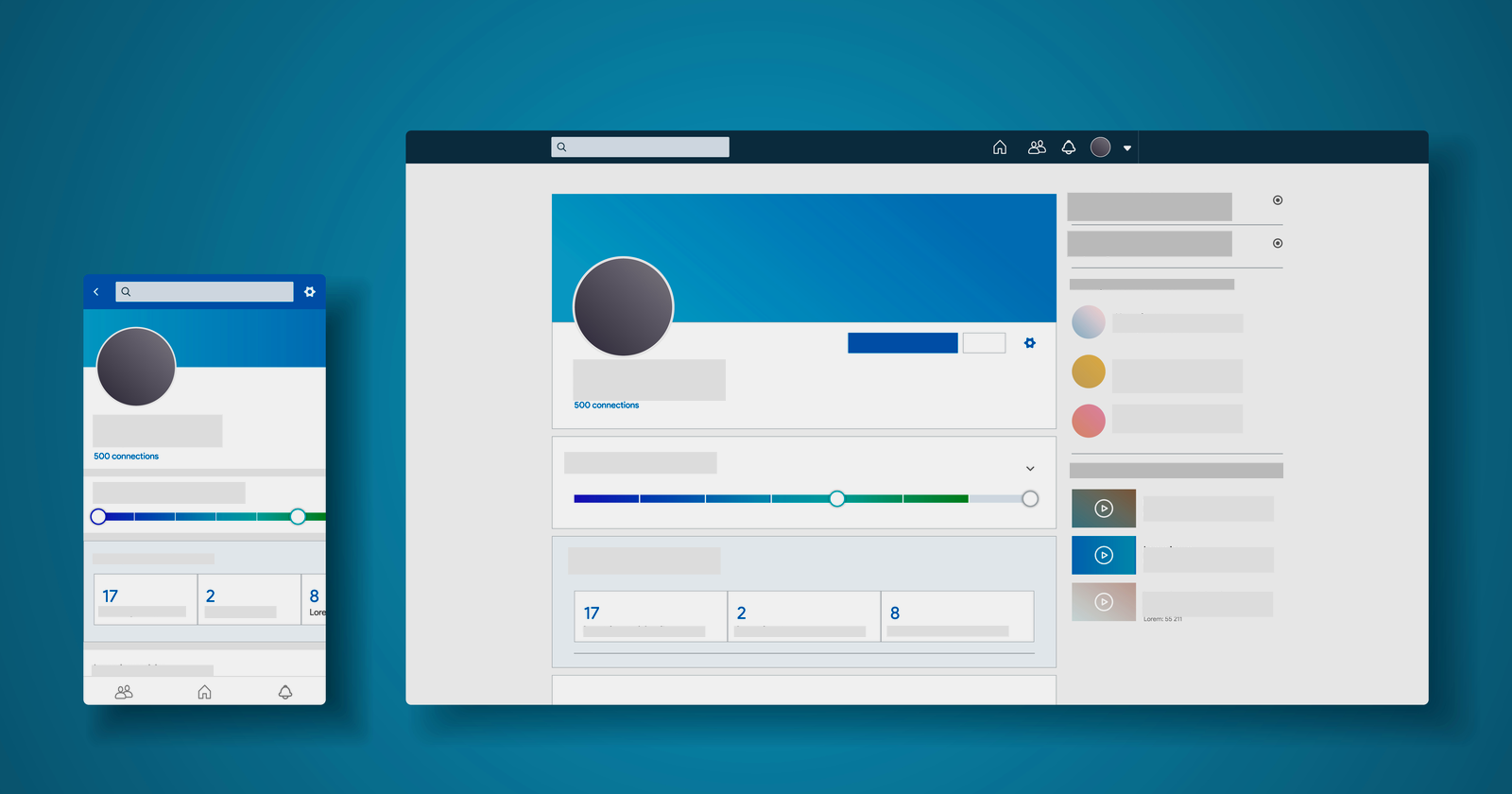My first introduction to LinkedIn was in my senior year of college, when it was a requirement of my Career Preparation class to complete a LinkedIn profile.
I remember putting up a recent selfie (professional photography was not in the budget) as my profile photo and listing “Student” as my job title.
Fortunately, LinkedIn has come a long way since the age of treating your profile as an online resume.
While the result – landing new clients or a new job – can be the same, the method for making your profile work to your benefit is quite different.
Here’s how the LinkedIn algorithm works today, and how to use it to serve your SEO and marketing goals.
What Is LinkedIn?
LinkedIn is the largest professional online networking platform in the world.
More than a social media channel, LinkedIn can be used to connect with friends, family, and colleagues, and to expand your career prospects via new contacts, online learning, and more.
Advertisement
Continue Reading Below
In short, LinkedIn is much more than simply a resume site. Far from exhaustive, here is a list of a few things you can do on LinkedIn:
- Connect with friends and family.
- Connect with work colleagues and other professional contacts.
- Meet new industry professionals.
- Re-share posts, articles, and videos.
- Publish your own posts, articles, and videos.
- Create a LinkedIn Company page.
- Read “LinkedIn News.”
- Use hashtags.
- Plan and schedule Events.
- Post jobs and internships.
- Search for jobs and internships.
- Send direct messages.
- View Insights and generate leads with Sales Navigator.
- Advertise with LinkedIn Ads.
- Join Groups.
- Improve your skills with LinkedIn Learning.
What Does The LinkedIn Algorithm Do?
Like most social media sites and search engines, LinkedIn has its own algorithm to help you (as a user) connect with other people, find jobs, find interesting content, and surface any other information you want to find on the platform.
But this algorithm also works in another way.
The LinkedIn algorithm also helps other users find you, much like how Google helps your website reach other users.
So whether your goal is networking, lead generation, growing an audience, or beyond, LinkedIn can be a great tool for drumming up more visibility for your business or personal brand.
Advertisement
Continue Reading Below
How The LinkedIn Algorithm Works
Pete Davies, the senior director of product management, was has said that LinkedIn’s mantra is, “People you know, talking about the things you care about.”
I can’t think of a better summation of what LinkedIn’s feed is all about. LinkedIn truly prioritizes personal connections and relevant content.
Prioritize Relevant Content
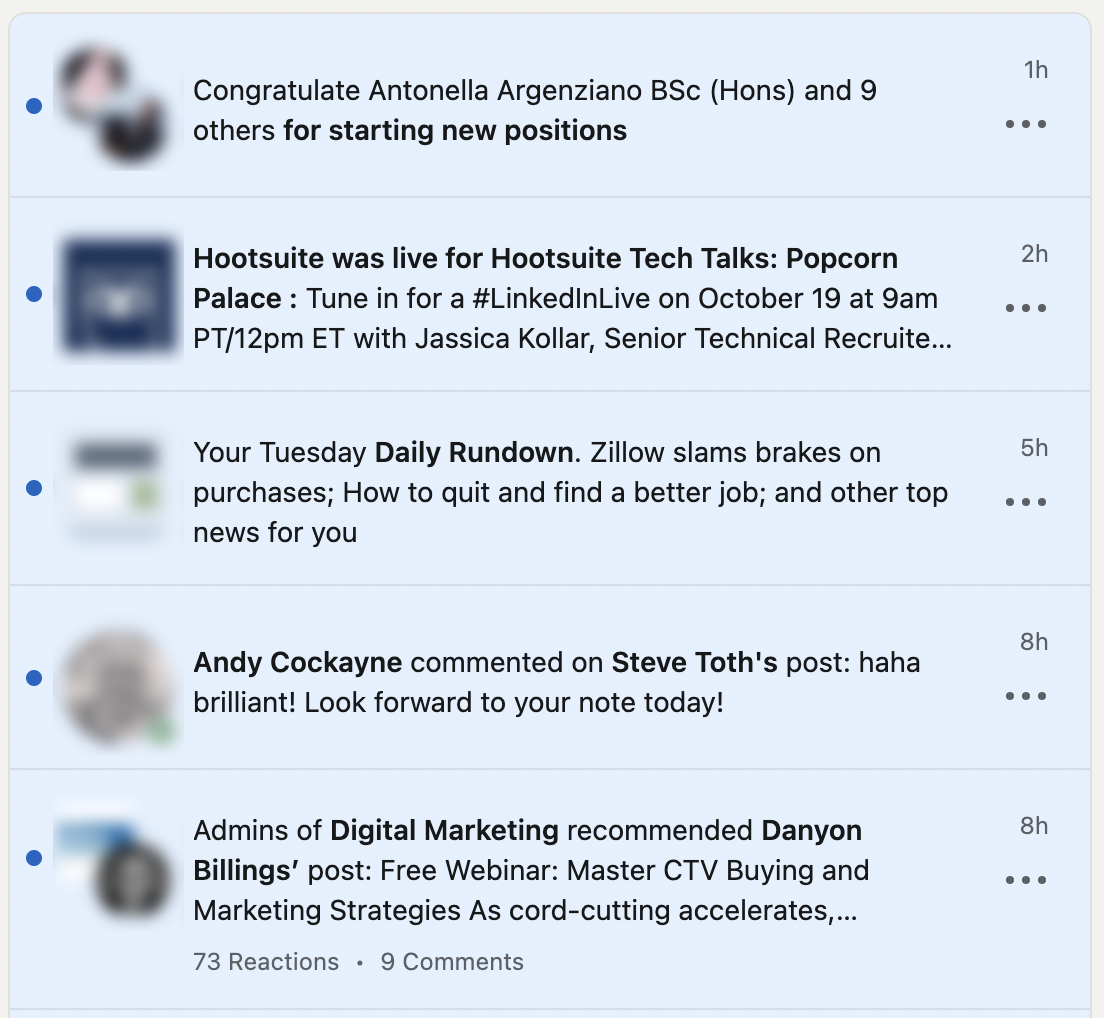 Screenshot from Linkedin.com, October 2021
Screenshot from Linkedin.com, October 2021LinkedIn’s algorithm highly favors relevancy over recency. Its goal is to show users content that’s of interest to them, even ahead of more recent posts.
In this way, LinkedIn is able to display articles, videos, job listings, and more which best fit what the user is looking for – or at least most likely to engage with.
Promote User Engagement
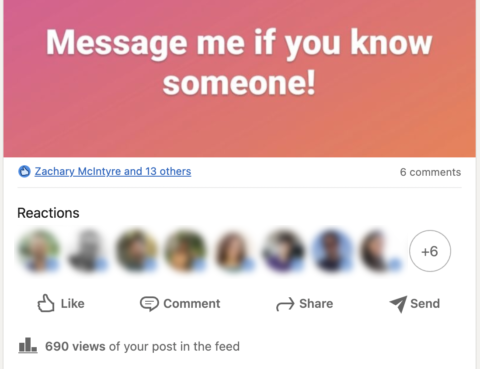 Screenshot from Linkedin.com, October 2021
Screenshot from Linkedin.com, October 2021This brings us to the second purpose of the algorithm, which is to encourage user engagement.
Displaying relevant content to users encourages them to continue using the platform, re-sharing content, and even investing in LinkedIn advertising.
Advertisement
Continue Reading Below
I’m continuously shocked by the virality of some posts I’ve seen on LinkedIn.
Despite your Connection count, your posts have the potential to reach a much wider audience, even generating thousands of views, likes, and comments.
LinkedIn Ranking Signals For More Connections And Views
Like Google, LinkedIn employs its own “ranking signals” to determine what content should be displayed, how often, and to what audience.
In short, harnessing the power of these ranking signals could help your content reach more users, land you more jobs, and grow your audience.
Connections
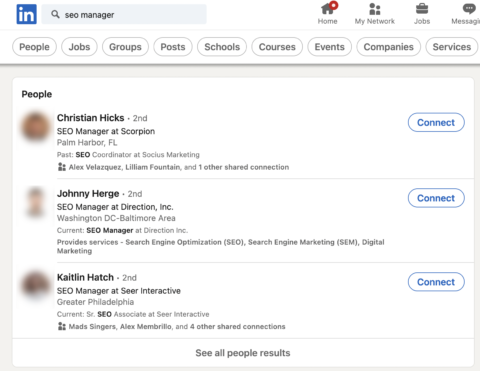 Screenshot from Linkedin.com, October 2021
Screenshot from Linkedin.com, October 2021LinkedIn considers the varying “degrees” (first, second, third, and fourth+) of Connections when determining who or what is most relevant to your interests.
Advertisement
Continue Reading Below
In simpler terms, on LinkedIn, it really matters who you know.
A larger LinkedIn network means more Connections, which means more opportunities to virtually bump elbows with other professionals. With this, your content can be displayed to users far beyond your first-degree Connections, and vice versa.
Further, LinkedIn’s algorithm also considers who you’ve interacted with on the platform, via comments, likes, shares, and reactions.
LinkedIn is then likely to show you content outside your immediate network that aligns with the types of content (and people) you have interacted with in the past.
Content Relevance
LinkedIn’s algorithm also measures how relevant a user’s content is to your interests. It “reads” the types of hashtags, posts, pages, and profiles you have engaged with the most.
Again, LinkedIn will even display content outside your immediate Connections based on your previous online behavior. This way, you can discover relevant topics, job postings, people, and more.
Engagement
As with many platforms, Engagement is an important signal when it comes to determining what a user likes and wants to see on the platform.
Advertisement
Continue Reading Below
LinkedIn’s algorithm interprets likes, shares, comments, Connection requests, and other engagement factors to determine the likelihood of you engaging with another piece of content.
Additionally, LinkedIn considers timeliness and the “virality” of the content to decide what to include in other users’ news feeds. If a post “takes off,” so to speak, LinkedIn is even more likely to push it out to a wider network.
How To Win With SEO On LinkedIn
LinkedIn uses the above signals to determine how to “filter” users’ content and display it to other users. The good news is that this is not a complicated algorithm to master!
Below, I dive into some tips on how to use LinkedIn to your advantage.
1. Conduct “Keyword Research”
While the SEO world equips us with many handy tools for conducting Google keyword research, we don’t have quite as many resources at our disposal when it comes to LinkedIn.
But no worries! LinkedIn research becomes rather simple when you know where to look.
Advertisement
Continue Reading Below
For example, assume you want to “rank” in LinkedIn search for “SEO copywriter,” but aren’t sure if this is the right term to use or how to optimize for it.
An initial search for “SEO copywriter” in LinkedIn search will generate an array of results, which will indicate what terms are being used by other profiles and how.
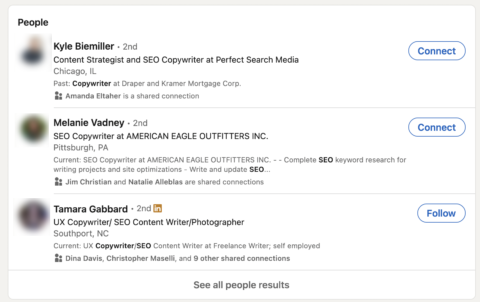 Screenshot from Linkedin.com, October 2021
Screenshot from Linkedin.com, October 2021In the image above, we see how LinkedIn is showing me profiles that are at the second degree of Connection – not first – which means that even if I have SEO copywriters in my network, the ones that are “ranking” must be doing something different in terms of optimizing their profiles.
Advertisement
Continue Reading Below
A quick glance at their Headlines shows that they are, in fact, using the keyword “SEO copywriter.”
 Screenshot from Linkedin.com, October 2021
Screenshot from Linkedin.com, October 2021And when I click on See all people results, I see that essentially 123,000 people are ranking for this term. This gives me some idea of the competition level of this term.
But I don’t want to stop my keyword research here; I will need to try other variations (“SEO writer,” “web content writer,” etc.) to determine what LinkedIn’s algorithm is prioritizing in the search results.
Advertisement
Continue Reading Below
2. Optimize Your Profile
Once you’ve determined which terms you want your profile to rank for (whether it’s to attract clients, Connections, or jobs), you can optimize your profile to increase your chances of ranking.
Your Headline, About section Description, and Experience section are all ample real estate where you can include your target keyword(s) and provide additional context that describes what you do or what you offer.
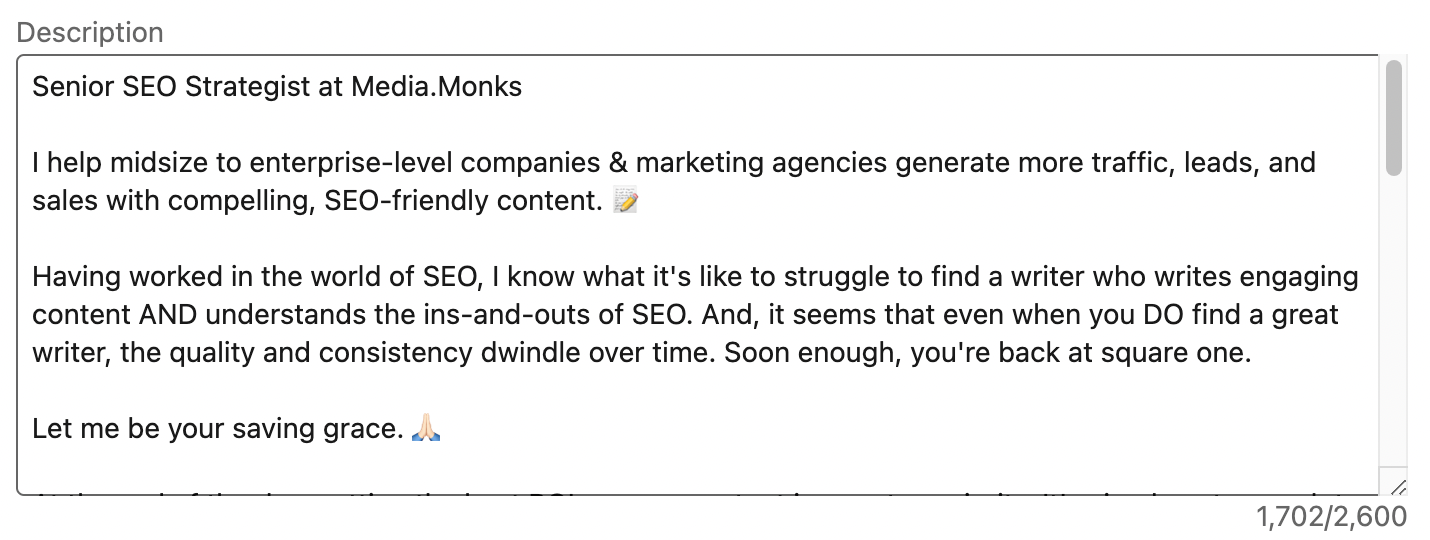 Screenshot from Linkedin.com, October 2021
Screenshot from Linkedin.com, October 2021As an SEO content strategist, I want my profile to rank for “SEO,” “content,” “writer,” and the like. Rather than target a single, long-tail term, I can use all of these terms throughout my profile in order to rank for a variety of searches.
 Screenshot from Linkedin.com, October 2021
Screenshot from Linkedin.com, October 2021I’ve completely filled out the Experience section of my profile to tell users and the algorithm what it is that I do – without all-out keyword-stuffing by job descriptions.
Advertisement
Continue Reading Below
After all, the goal is to not only attract users but to convince them to work with, Follow, or hire you.
Here are a few other ways to optimize your LinkedIn profile:
- Include a professional profile image to encourage clicks.
- Add a professional and descriptive Cover photo to attract Connections and even direct users to your website.
- Include a link to your website or blog.
- Add additional media (with descriptions) like blog articles and videos.
- Ask past employers or contacts for Recommendations that are relevant to your offering and/or what you want to rank for.
- Add Skills that are relevant to the terms you want to rank for. Highlight your top three Skills.
3. Build More Connections
On LinkedIn, the more (relevant) Connections you have, the better. Again, this is because not only will your content be displayed to you first degree Connections, but to their Connections (second degree) and so forth.
I encourage users to aim for at least 500 Connections, as this seems to be the “magic number” in terms of virality (based on the small sample size I gathered via optimizing client profiles). Users with 500 Connections or more are more likely to see high visibility on their posts (as reflected by their Analytics).
 Screenshot from Linkedin.com, October 2021
Screenshot from Linkedin.com, October 2021The more Connections you have, the more likely it is that your profile will appear in LinkedIn search and that your posts will be shown outside of your immediate network. (This is how I use LinkedIn as a passive lead generation tool for my agency).
Advertisement
Continue Reading Below
4. Engage With Users’ Posts
Finally, with Engagement being a significant ranking factor for the LinkedIn algorithm, it is very important to engage with others’ posts.
This is not simply an indication to a single user that you link their content, but LinkedIn will even show your interaction to other users.
 Screenshot from Linkedin.com, October 2021
Screenshot from Linkedin.com, October 2021Russel Brunson – a big wig in the marketing space – is not someone I follow on LinkedIn, nor is he a Connection of mine, but still I see what he “commented” on this post by Houston Golden.
Advertisement
Continue Reading Below
In my feed, LinkedIn is showing me content that other marketers are interacting with.
You don’t need to be a major player to get your content shown to other users, though.
Anyone can “rank” in anyone’s feed, even based on a single interaction. With this in mind, liking and commenting on content can attract more eyes to your profile.
This is how even some of the smallest content creators go “viral.” If someone with a larger following interacts with their content, it can be displayed to a wider audience, and then the visibility grows exponentially.
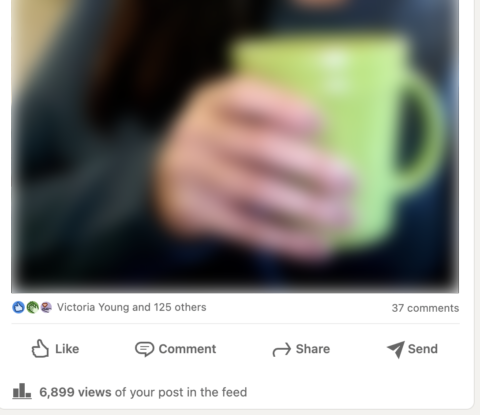 Screenshot from Linkedin.com, October 2021
Screenshot from Linkedin.com, October 2021And it’s how this simple post of me holding a cup of coffee was able to generate over 6,800 views!
Advertisement
Continue Reading Below
Why LinkedIn Matters For SEO
LinkedIn can be a powerful tool for driving more users to your profile, whether the goal is to win clients, grow an audience, land a job, or grow your personal brand.
Using the LinkedIn algorithm to your advantage is just another way to make SEO work for you.
Keyword research and profile optimization on the platform allow you to grow your network, get more eyes on your content, and even drive leads to your inbox.
You can essentially “rank” in LinkedIn search by optimizing for your target terms and building Connections with the right people.
Use LinkedIn SEO to grow your business – or even go into the business of LinkedIn optimization to help others grow instead!
More Resources:
Featured Image: art.em.po/Shutterstock
